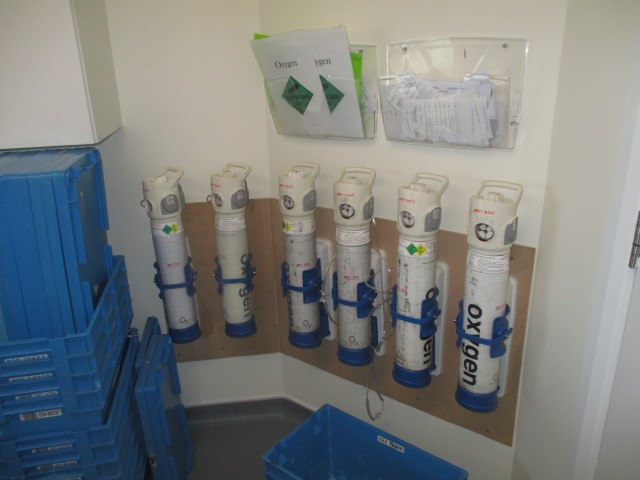
The Use of Oxygen –
Oxygen is naturally occurring within the air we breath, it is odourless, colourless and a tasteless gas that is slightly heavier than air. Oxygen gas is not flammable, however, if released in to the atmosphere within a building, it will enrich normal atmospheric content levels and would accelerate a fires development.
The concentrated use of oxygen (often referred to as oxygen therapy) is commonly used in Care Homes, particularly those providing nursing care, to help manage a variety of conditions. It can be dispensed via a cylinder, concentrator or ventilator machine, depending on the residents’ needs.
Hazards
Although oxygen is always present in the air we breathe, even a slightly enriched oxygen atmosphere can make it easier for a fire to start, and to burn more ferociously than would usually be the case and may be extremely difficult to extinguish.
Oxygen is also very reactive and can respond violently with materials commonly used in case homes such as unevaporated alcohol based hand wash gels, flammable cleaning wipes, flammable aerosols, paraffin based emollient creams, oil based moisturisers, sun cream and petroleum based products such as vaseline. Many materials, including textiles, rubber and even metals, will burn more vigorously in oxygen enriched environments.
Safe Use and Storage
- Do not use petroleum based products, such as Vaseline near oxygen.
- Do not store in rooms subject to extremes of hot and cold temperature such as conservatories, plant/boiler rooms, kitchen, unheated areas of the building etc.
- Do not allow people to smoke near where oxygen is being stored or used.
- Keep oxygen at least two metres away from flames or heat sources.
- Only store the minimum quantity required to maintain the continuity of care. Under no circumstance should oxygen cylinders be ‘stockpiled’.
- Keep cylinders chained or clamped to prevent them from falling over.
- Store oxygen cylinders when not in use in a well-ventilated room or compound, away from combustible materials, greases, and paints etc.
- Treat empty cylinders with the same caution as you would a full one.
- Portable cylinders for the evacuation of highly oxygen dependant residents should be kept in the same fire compartment as their bedroom.
- Do not cover the cylinders with goods, cardboard, clothes and/or fabrics etc.
- Do store within a locked room or cage.
- Avoid the use of electrical equipment such as laptops with the residents bedroom (particularly if the resident is nursed in bed).
- Only allow trained staff to use/transport oxygen cylinders and concentrators.
- If the resident has mental capacity, advise the resident of the risks associated with the use of oxygen.
- Regularly check the condition of tubing (look for kinks etc) and filters (check for blockages/the built up of previously airborne materials).
- Regularly check the condition of concentrators and associated electrical cables.
- Check flow rates are at the prescribed level.
Recommended Policies and procedures
- Make sure that all staff understand the risks associated with oxygen.
- Floor plans for emergency use should identify the location of oxygen cylinders and concentrator/ventilator machines.
- Doors to rooms holding oxygen cylinders should display an oxygen warning sign (including the residents’ bedroom).
- Follow manufacturers/suppliers guidance concerning maintenance and safe use of oxygen equipment.
- Do not store more than you need.
- Residents receiving oxygen therapy (and any staff member or visitor in their presence) should not smoke, including e-cigarettes.
- When using an oxygen concentrator, avoid the use of an extension lead, plug directly into a fixed socket.
Action to be Taken in the Event of a Spillage
If there is a known spillage of oxygen, turn off the cylinder valve immediately and open all windows and doors in the area to ventilate the room/dilute the oxygen level back down to normal levels, do not use electrical switches.
Occupants of the spillage room (both residents and staff) should avoid ignition source areas (kitchens/kitchenette areas, hair salons, laundry rooms, boiler rooms, smoking areas, IT rooms etc.) and proceed directly to an external area. They should the vigorously shake down their clothing as it could be oxygen enriched.
Transportation of cylinders
Cylinders should only be transported to and from the Home by authorised suppliers. Under no circumstance should employees collect cylinders in either their own or company vehicles, similarly they should not return unwanted or ‘empty’ cylinders in their own cars.
Within the Home, larger cylinders should only be transported to the point of use on purpose made trollies. Smaller portable cylinders should be transported by use (including any occasion whereby the residents is in the community) of purpose made carry bags. Portable cylinders not be taken in to any company vehicles, residents vehicles, taxi’s etc.
References
Policy and procedural documentation produced by Marpal Limited
NHS England
CQC, Managing Oxygen in Care Homes (last updated 02 December 2019)
HSE:- Oxygen use in the workplace (published 01/13)
BOC Healthcare :- Cylinder storage and handling
BOC Healthcare :- Compressed medical oxygen, Essential safety information
Need Help?
Marpal are a Health and Safety Consultancy who predominantly operate in the Care Sector. If you require a Fire Risk Assessment or Fire Consultancy regarding the safe storage/location of oxygen bottles, then please call us today on 01332 668877 or email us at [email protected].


